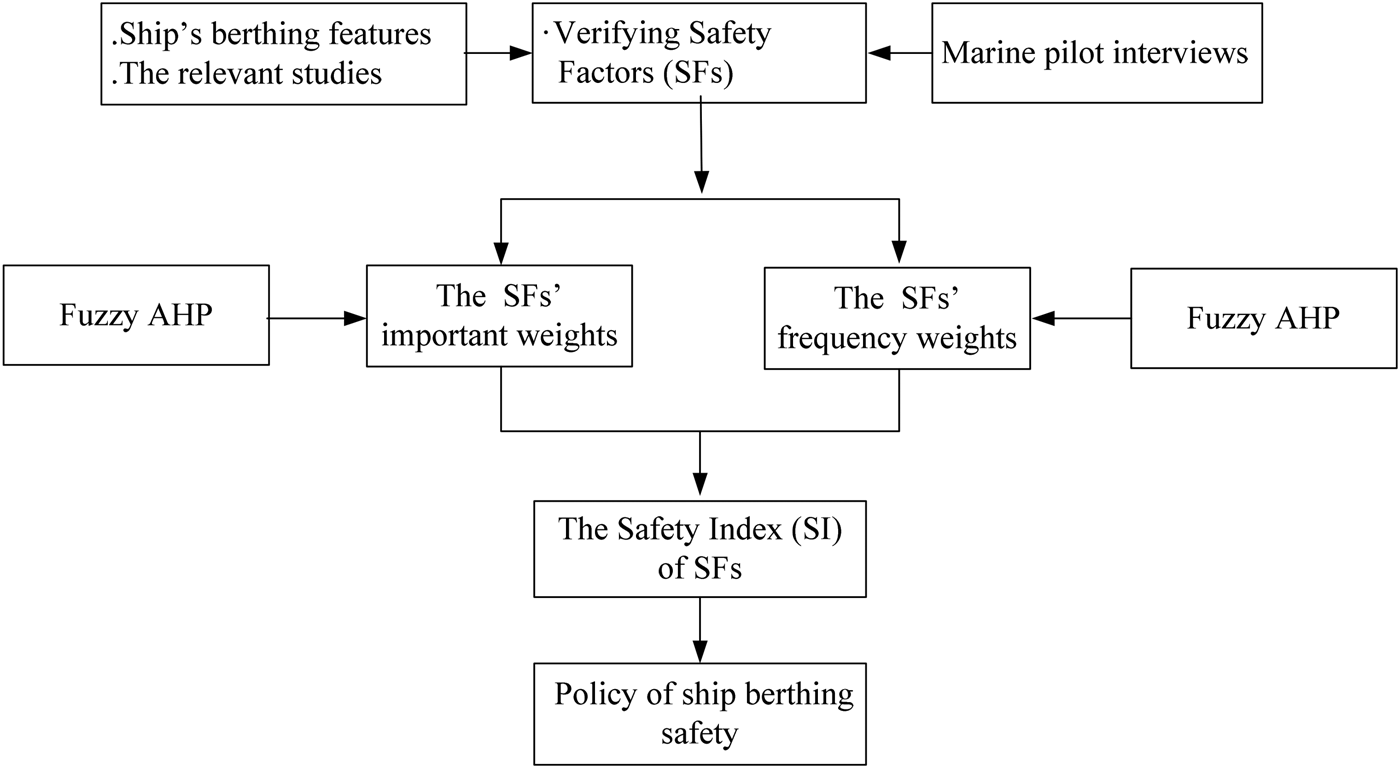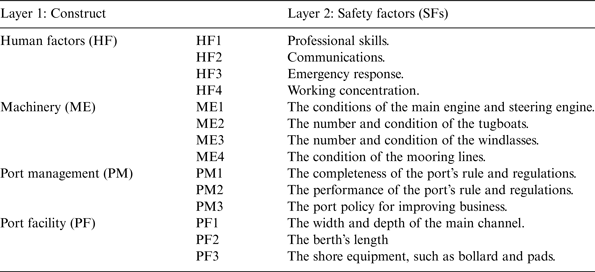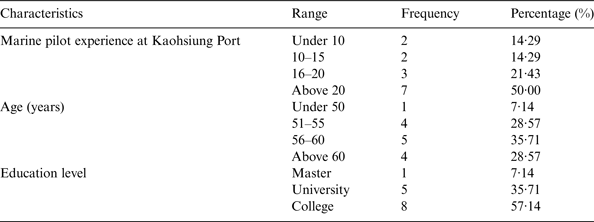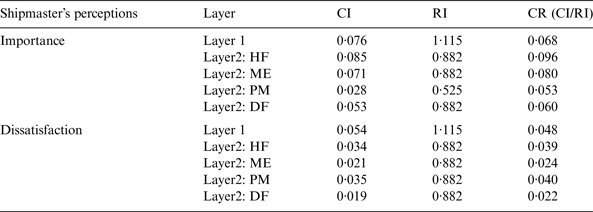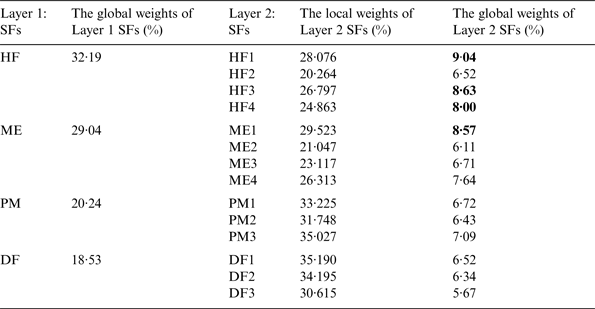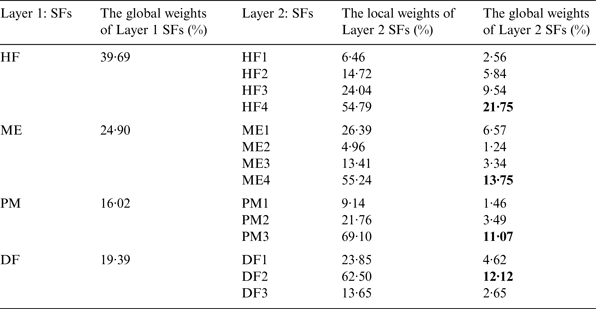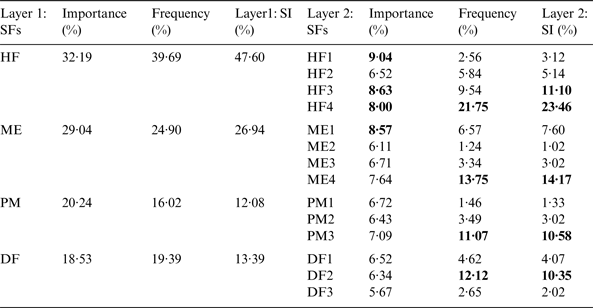1. INTRODUCTION
Recently, in line with increasing global trading activities, shipping companies are continuing to build ever larger vessels for shipping markets. The ships in the world, therefore, are not only becoming faster and larger, but also rapidly increasing in quantity. Under restricted shipping lanes, a growing number of vessels may lead an increased likelihood of maritime accidents (Hsu, Reference Hsu2012).
Generally, a ship accident may result in an expensive loss. The most common damage caused by a ship accident includes human casualties, port facility damage, cargo damage and vessel damage. In practice, those damages may harm the reputations of shipping carriers and port companies, which may lead to decreased business. A ship accident in port may cause fuel or cargo oil leakage, leading to port pollution. Since the losses from a ship accident can be enormous, many port authorities in the world have paid attention to reducing the incidence of ship accidents in port (Debnath et al., Reference Debnath, Chin and Haque2011).
Practically, common ship accidents include collisions and grounding, in which collisions are the most frequent maritime accident (Debnath and Chin, Reference Debnath and Chin2010; Hsu, Reference Hsu2012). In practice, collisions most commonly occur when ships berth. Thus, to reduce ship accidents, issues related to ship berthing safety should be considered. Unfortunately, in the relevant literature, there is a lack of studies on such topics.
The purpose of this paper is to discuss the safety of ship berthing operations in port. Based on the relevant literature and the features of ships' berthing operations, the Safety Factors (SFs) of ship berthing are first investigated. Since, ship berthing safety is a highly professional issue, a Safety Index (SI) based on a Fuzzy Analytic Hierarchy Process (AHP) model is then proposed to assess those SFs. The Safety Index consists of two weights, the SFs' importance weight and frequency weight. The former is defined as the effect of a SF in causing a ship accident, while the latter is explained as the frequency of the SF causing a ship accident. In practice, the former depends on the SF's features, and the latter depends on the performance of port management. In the relevant literature, most studies only focus on the former (e.g. Lu and Tsai, Reference Lu and Tsai2008; Hsu, Reference Hsu2012). Based on the Safety Index (SI), port authorities and carrier managers may make policies to improve ship berthing safety at docks. Finally, as an empirical study, the carriers berthing their ships at Kaohsiung port in Taiwan were investigated to validate the model. The rest of this paper is organised as follows. Section 2 reviews the literature. Section 3 explains the research method in this paper. The results are then examined in Section 4. Finally, some general conclusions and limitations for further research are given.
2. LITERATURE REVIEWS
Based on the relevant research and the features of ships' berthing operations, this paper reviews the literature on ship berthing safety from seven dimensions: marine pilot, ship factor, tugboat operation, dock operation, port management, operating staffs' health, and weather and geography.
2.1. Marine pilot
For many ship berthing operations, a marine pilot is often conducting the shiphandling. Thus, the professional skills of the marine pilots may be considered an important determinant of the operations. Further, the workplace of a marine pilot on a vessel is an international environment, where the pilot deals with crews from different cultures that speak different languages. Thus poor communication may lead to crews misunderstanding the pilot's steering order, and as a result, reduce the ship's berthing safety. Therefore, in addition to professional skills, a marine pilot's language ability, and communication ability may also affect ship berthing operations at ports. Previous studies have shown that poor communication between crews and marine pilots was a major factor in marine disasters near ports (Hetherington et al., Reference Hetherington, Flin and Mearns2006; Darbra et al., Reference Darbra, Crawford, Haley and Morrison2007; Hsu, Reference Hsu2012). Further, the language and cultural diversity of seafarers may affect shipping safety (Hetherington. et al., Reference Hetherington, Flin and Mearns2006; Knudsen and Hassler, Reference Knudsen and Hassler2011).
2.2. Ship factor
In practice, for ship berthing safety, the ship factor comprises ship staff and berthing equipment condition. The former includes the ship crews' operational skills and work attitudes in cooperating with the pilot; while the latter contains the conditions of equipment such as steering gear and windlasses. Past studies have indicated ship workers' professional skills and work attitudes may affect ship navigation safety (Lu and Tsai, Reference Lu and Tsai2008). Feedback from crews to the ship master significantly affect the reporting performance (frequency) of shipping accidents, and so do the interpersonal relationships and communication among crews (Oltedal and McArthur, Reference Oltedal and McArthur2011). A ship crew's improper operation, machinery failure (Darbra et al., Reference Darbra, Crawford, Haley and Morrison2007) and vessel performance (Liu et al., Reference Liu, Liang, Su and Chu2006; Hsu, Reference Hsu2012) may also lead to marine disasters. The type, size, age and condition of the vessel at the time of the accident are also important factors (Kokotos and Smirlis, Reference Kokotos and Smirlis2005).
2.3. Tugboat operation
The main operations of tugboats are to assist vessels in berthing alongside and departing from docks, including pushing and towing the vessels. The previous studies showed tugboat failure is one of the causes of marine accidents in ports (Darbra et al., Reference Darbra, Crawford, Haley and Morrison2007). Further, the factors affecting the quality of tugboat operations include the number of tugboats, the horsepower of the tugboat, and the operating skills of the tugboat drivers (Hsu, Reference Hsu2012).
2.4. Dock operation
For ship berthing safety, the dock operation factor contains line handling operation and dock facilities. Relevant studies have indicated the operating skills and work attitudes of linemen may affect ship navigation safety in port (Hsu, Reference Hsu2012). The number of windlasses in the dock and the operating location of the line handling boat (mooring buoy operation) may be another determinant of ship berthing safety (Chiu, Reference Chiu2013). As for the dock facility, in practice, the berth's length should be the most important factor to affect ship berthing safety. Practically, the berth's length should be 1·2 times longer than the berthing vessel (Liu et al., Reference Liu, Liang, Su and Chu2006) to provide the vessel enough space for ship mooring operations. However, due to the global development of large-sized ships, the space may frequently be decreased, leading to collisions between neighbouring ships.
2.5. Port management policy
This factor contains two parts:
2.5.1. Port management regulations
To ensure port safety, port authorities may develop related rules to regulate ships' operations in port. For example, in Kaohsiung port, the relevant regulations for ship's berthing operations include: marine pilot laws, ship navigation regulations in port, tugboat operator regulations and line handling operator regulations. Previous studies indicate the safety management system is a determinant of offshore safety (Wang, Reference Wang2002). However, in practice, those rules or systems may not be completely developed, and the operators may not comply with them perfectly.
2.5.2. Port policy to improve business
In order to increase business, the port authority may allow too many ships to berth simultaneously, increasing the density of ships in ports. This may result in rushed ship berthing operations, which could lead to more ship collisions. Relevant studies indicate ship collision risks increase with the density of ship at a specific water area (Debnath et al., Reference Debnath, Chin and Haque2011). Further, another policy for improving the port's business is to speed up the logistic operations of terminals. This may result in the berthing operations to be performed hastily, which may also lead to more ship accidents (Hsu, Reference Hsu2012).
2.6. The operating staff's health
The operating staff of a ship's berthing operations include marine pilots, ship crews, tugboat drivers and linesmen. In practice, the staff need to work in shifts. Therefore, their physical and mental health may affect their working concentration, which may influence ship navigation safety (Hsu, Reference Hsu2012). Previous research illustrated there were potentially disastrous outcomes from fatigue in terms of poor health (Josten, et al., Reference Josten, Ng-A-Tham and Thierry2003; Hetherington, Reference Hetherington, Flin and Mearns2006). Shift patterns contribute to fatigue and in turn cause poorer health and safety performance (IskraGolec, et al., Reference IskraGolec, Folkard and Noworol1996).
2.7. Weather and geography
Past studies have indicated weather and geography are common factors leading to shipping accidents (Ugurlu et al., Reference Ugurlu, Kose, Yildirim and Yuksekyildiz2014). Hsu et al. (Reference Hsu, Chang and Chou2008) examined the relations between the type of marine casualties and the places that disasters occurred. This revealed the most frequent marine casualties were collisions, and the layout of berth and the water area of the port were highly related to collisions and groundings. Kokotos and Smirlis (Reference Kokotos and Smirlis2005) indicated the weather, sea condition and the location of ship are important factors in predicting ship loss. Ismail and Karim (Reference Ismail and Karim2013) investigated the cause of tanker spill accidents and concluded storms and hurricanes are the second most common cause of ship accidents (31·8%) after navigation errors (42·5%).
3. RESEARCH METHOD
3.1. Research Framework
The research framework of this paper is shown in Figure 1. The Safety Factors (SFs) for ships' berthing operations are first investigated. A fuzzy AHP model (Hsu and Huang, Reference Hsu and Huang2014) is then proposed to weight both the SFs' importance and frequency degrees. Based on those two weights, a Safety Index (SI) is finally created to assess the ship berthing safety, by which port managers and ship carriers may make policies to improve ship berthing safety at port docks.

Figure 1. Research framework.
3.2. Measurement of safety factors
3.2.1. The definitions of safety factors
Based on the features of ship berthing operations and interviews with several marine pilots, we reorganised the determinants mentioned in previous research, and identified the SFs as four dimensions, in which the weather and geography is not considered for it is a natural factor.
3.2.1.1. Human factor
For ship berthing, the operating staff include the marine pilot, ship crews, tugboat drivers and linesmen. The human factor is defined as the capabilities of the staffs, including professional skill, communication, emergency handling and working concentration.
3.2.1.2. Machinery (ME)
Machinery is defined as the conditions of machines and equipment for ship berthing operations, including the main engine and steering gear of ship, tugboats, deck machines (windlasses) and mooring lines.
3.2.1.3. Port management (PM)
Port management is defined as the completeness and performance of the rules or regulations for ship berthing operations, and the policy for improving the business of the port, such as speeding up the logistical operations, encouraging large ships to stay, etc.
3.2.1.4. Port facility
Port facility is defined as the port equipment for ship berthing operations, including berth length and the conditions and number of bollards and fender pads.
Based on the above definitions, a two-layer hierarchy structure of SFs for ship berthing safety was first constructed. To improve the practical validity of the SFs, three practical marine pilots were then invited to revise those SFs and check if any important SFs were missed. Further, they also checked the independences among those SFs. After several rounds of discussions and revisions, the final hierarchy structure of the SFs, shown in Table 1, contains four dimensions of SFs for the first layer and 14 SFs for the second layer.
Table 1. Hierarchical structure of safety factors (SFs) for ship berthing operations.

3.2.2. Questionnaire design
In this paper, an AHP questionnaire (Saaty, Reference Saaty1980) with a nine point rating scale was designed to measure the marine pilot's perceived “importance” and “frequency” toward each SF respectively. Based on the hierarchical structure of SFs in Table 1, an AHP questionnaire with five criteria and 14 sub-criteria was created. To validate the scale, the questionnaire was then pre-tested by the three previous marine pilots to check if the statements were understandable.
3.2.3. Research Sample
In practice, the marine pilot is the main operator for ship berthing operations. Thus, the marine pilots of Kaohsiung Port were surveyed in this paper. To enhance the validity of the survey, an assistant was dispatched to help the respondents fill out the questionnaire. Currently, there are 42 marine pilots at Kaohsiung Port, from which we surveyed 16 marine pilots randomly and interviewed them in May 2013. For each of the sample, the Consistency Index (CI) was first calculated to test the consistency of its pairwise comparison matrix. The results indicated two samples with CI > 0·1 were highly inconsistent (Saaty, Reference Saaty1980). Therefore, these two questionnaires were discarded. The profiles of the validated 14 respondents' characteristics are shown in Table 2. It shows all of the subjects have at least ten years of experience with over 80% respondents having over 20 years. Note the remarkable qualifications of the respondents endorse the reliability of the survey findings.
Table 2. Profile of the respondents.

3.3. The weights of safety factors
From the sample data, 14 pairwise comparison matrices were obtained for each comparison of the SFs in each layer. In the past, most relevant studies used the arithmetic mean or geometric mean to integrate multiple subjects' opinions. However, those two means are sensitive to extreme values. Thus, a fuzzy number is considered to integrate the subjects' perceptions in this paper. First, the geometric mean was employed to represent the consensus of respondents (Buckley, Reference Buckley1985; Saaty, Reference Saaty1980). A triangular fuzzy number characterised by minimum, geometric mean and maximum of the measuring scores was then used to integrate the 14 pairwise comparison matrices into a fuzzy positive reciprocal matrix. Based on the fuzzy reciprocal matrices, a fuzzy AHP approach was finally conducted to determine the weights of the SFs, including both of the measurements of important and frequency.
3.3.1. The fuzzy positive reciprocal matrix
Let ![]() ${\tilde A} = {[{\tilde a_{ij}}]_{n \times n}}$ be a fuzzy positive reciprocal matrix with n SFs, where
${\tilde A} = {[{\tilde a_{ij}}]_{n \times n}}$ be a fuzzy positive reciprocal matrix with n SFs, where ![]() ${\tilde a_{ij}} = [{l_{ij}},{\rm } {m_{ij}},{\rm } {u_{ij}}]$ is a triangular fuzzy number with
${\tilde a_{ij}} = [{l_{ij}},{\rm } {m_{ij}},{\rm } {u_{ij}}]$ is a triangular fuzzy number with
For ease of demonstration, let ![]() ${A^{(k)}} = {\left[ {a_{ij}^{(k)}} \right]_{n \times n}}$, k = 1, 2,…, m, denote the pair-wise comparison matrix of m subjects. Then, those m matrices can be integrated into the following fuzzy positive reciprocal matrix:
${A^{(k)}} = {\left[ {a_{ij}^{(k)}} \right]_{n \times n}}$, k = 1, 2,…, m, denote the pair-wise comparison matrix of m subjects. Then, those m matrices can be integrated into the following fuzzy positive reciprocal matrix:
where  ${\tilde a_{ij}} = \left[ {\mathop {\min} \limits_{1 \le k \le m} \left\{ {a_{ij}^{(k)}} \right\},{{\left( {\mathop \Pi \limits_{k = 1}^m a_{ij}^{(k)}} \right)}^{1/m}},\mathop {\max} \limits_{1 \le k \le m} \left\{ {a_{ij}^{(k)}} \right\}} \right]$ is a triangular fuzzy number, i = 1, 2,…, n, j = 1, 2,…, n and k = 1, 2,…, m.
${\tilde a_{ij}} = \left[ {\mathop {\min} \limits_{1 \le k \le m} \left\{ {a_{ij}^{(k)}} \right\},{{\left( {\mathop \Pi \limits_{k = 1}^m a_{ij}^{(k)}} \right)}^{1/m}},\mathop {\max} \limits_{1 \le k \le m} \left\{ {a_{ij}^{(k)}} \right\}} \right]$ is a triangular fuzzy number, i = 1, 2,…, n, j = 1, 2,…, n and k = 1, 2,…, m.
3.3.2. The consistency tests
Before calculating the weights of the SFs in the fuzzy positive reciprocal matrix (![]() ${\tilde A}$ ), an immediate problem is to test the consistency of
${\tilde A}$ ), an immediate problem is to test the consistency of ![]() ${\tilde A}$. The problem results from the fact that the criteria (SFs) within the
${\tilde A}$. The problem results from the fact that the criteria (SFs) within the ![]() ${\tilde A}$ are fuzzy numbers, so the consistency of
${\tilde A}$ are fuzzy numbers, so the consistency of ![]() ${\tilde A}$ cannot be tested directly as a traditional AHP. Buckley (Reference Buckley1985) conducted the consistency test for a fuzzy positive reciprocal matrix whose criteria are trapezoidal fuzzy numbers. He first used the geometric means to defuzzify the criteria and thus convert the fuzzy positive reciprocal matrix into a crisp matrix. Then, the consistency test can be undertaken for the crisp matrix, as traditional AHP. In this paper, we use the method of Buckley (Reference Buckley1985) to defuzzify the
${\tilde A}$ cannot be tested directly as a traditional AHP. Buckley (Reference Buckley1985) conducted the consistency test for a fuzzy positive reciprocal matrix whose criteria are trapezoidal fuzzy numbers. He first used the geometric means to defuzzify the criteria and thus convert the fuzzy positive reciprocal matrix into a crisp matrix. Then, the consistency test can be undertaken for the crisp matrix, as traditional AHP. In this paper, we use the method of Buckley (Reference Buckley1985) to defuzzify the ![]() ${\tilde A}$. Specifically, for the positive reciprocal matrix
${\tilde A}$. Specifically, for the positive reciprocal matrix ![]() ${\tilde A}$, the fuzzy numbers
${\tilde A}$, the fuzzy numbers ![]() ${\tilde a_{ij}} = [{l_{ij}},{\rm } {m_{ij}},{\rm } {u_{ij}}]$ can be defuzzified as:
${\tilde a_{ij}} = [{l_{ij}},{\rm } {m_{ij}},{\rm } {u_{ij}}]$ can be defuzzified as:
Generally, the following CI (Consistency Index) and CR (Consistency Ratio) are the two indices used to test the consistency of a crisp positive reciprocal matrix in traditional AHP:
and
where λ max is the maximum eigenvalue of the positive reciprocal matrix and n is the number of criteria in the matrix. The RI represents a randomized index, whose values are shown in Table 3 (Hsu and Huang, Reference Hsu and Huang2014). Saaty (Reference Saaty1980) suggested that a value for CR ≤ 0.1 is an acceptable range for consistency test of the crisp positive reciprocal matrix.
Table 3. The randomized index (RI)

In our sample data, the results of consistency tests are listed in Table 4. Since all of the C.R. indices in Table 4 are less than 0·1, all of the positive reciprocal matrixes in the sample data are consistent.
Table 4. The results of the consistency tests.

3.3.4. The local weights of SFs
The local weights of SFs can be determined from the eigenvectors of matrix ![]() ${\tilde A}$. However, due to the special structure of the positive reciprocal matrix, Saaty (Reference Saaty1980) suggested four methods to find the eigenvectors: Average of Normalized Columns (ANC), Normalization of the Row Average (NRA), Normalization of the Reciprocal of Columns Sum (NRCS) and Normalization of the Geometric Mean of the Rows (NGMR). Since the MGM method was applied most popularly in previous studies, this paper adopts the MGM to determine the local weights of SAs in matrix
${\tilde A}$. However, due to the special structure of the positive reciprocal matrix, Saaty (Reference Saaty1980) suggested four methods to find the eigenvectors: Average of Normalized Columns (ANC), Normalization of the Row Average (NRA), Normalization of the Reciprocal of Columns Sum (NRCS) and Normalization of the Geometric Mean of the Rows (NGMR). Since the MGM method was applied most popularly in previous studies, this paper adopts the MGM to determine the local weights of SAs in matrix ![]() ${\tilde A}$.
${\tilde A}$.
For the fuzzy positive reciprocal matrix ![]() ${\tilde A}$, the geometric means of the triangular fuzzy numbers for the ith SF (i = 1, 2,…, n) can be found as:
${\tilde A}$, the geometric means of the triangular fuzzy numbers for the ith SF (i = 1, 2,…, n) can be found as:
 $${\tilde w_i} = {\left( {\mathop \Pi \limits_{\,j = 1}^n {{\tilde a}_{ij}}} \right)^{1/n}} = \left[ {{{\left( {\mathop \Pi \limits_{\,j = 1}^n {l_{ij}}} \right)}^{1/n}},{\rm} {{\left( {\mathop \Pi \limits_{\,j = 1}^n {m_{ij}}} \right)}^{1/n}}{\rm,} {{\left( {\mathop \Pi \limits_{\,j = 1}^n {u_{ij}}} \right)}^{1/n}}} \right],{\rm} i = 1,2,...,n.$$
$${\tilde w_i} = {\left( {\mathop \Pi \limits_{\,j = 1}^n {{\tilde a}_{ij}}} \right)^{1/n}} = \left[ {{{\left( {\mathop \Pi \limits_{\,j = 1}^n {l_{ij}}} \right)}^{1/n}},{\rm} {{\left( {\mathop \Pi \limits_{\,j = 1}^n {m_{ij}}} \right)}^{1/n}}{\rm,} {{\left( {\mathop \Pi \limits_{\,j = 1}^n {u_{ij}}} \right)}^{1/n}}} \right],{\rm} i = 1,2,...,n.$$From Equation (5), we have:
 $$\sum\limits_{i = 1}^n {{{\tilde w}_i}} = \left[ {\sum\limits_{i = 1}^n {{{\left( {\mathop \Pi \limits_{\,j = 1}^n {l_{ij}}} \right)}^{1/n}}}, {\rm} \sum\limits_{i = 1}^n {{{\left( {\mathop \Pi \limits_{\,j = 1}^n {m_{ij}}} \right)}^{1/n}}}, {\rm} \sum\limits_{i = 1}^n {{{\left( {\mathop \Pi \limits_{\,j = 1}^n {u_{ij}}} \right)}^{1/n}}}} \right].$$
$$\sum\limits_{i = 1}^n {{{\tilde w}_i}} = \left[ {\sum\limits_{i = 1}^n {{{\left( {\mathop \Pi \limits_{\,j = 1}^n {l_{ij}}} \right)}^{1/n}}}, {\rm} \sum\limits_{i = 1}^n {{{\left( {\mathop \Pi \limits_{\,j = 1}^n {m_{ij}}} \right)}^{1/n}}}, {\rm} \sum\limits_{i = 1}^n {{{\left( {\mathop \Pi \limits_{\,j = 1}^n {u_{ij}}} \right)}^{1/n}}}} \right].$$Also, from Equations (5) and (6), the fuzzy weight of the ith SF (i = 1, 2,…, n) can then be obtained as:
 $$\eqalign{{\widetilde W_i} = {\tilde w_i}/\sum\limits_{i = 1}^n {{{\tilde w}_i}} = \left[ {\displaystyle{{{{\left( {\mathop \Pi \limits_{\,j = 1}^n {l_{ij}}} \right)}^{1/n}}} \over {\sum\limits_{i = 1}^n {{{\left( {\mathop \Pi \limits_{\,j = 1}^n {u_{ij}}} \right)}^{1/n}}}}}, {\rm} \displaystyle{{{{\left( {\mathop \Pi \limits_{\,j = 1}^n {m_{ij}}} \right)}^{1/n}}} \over {\sum\limits_{i = 1}^n {{{\left( {\mathop \Pi \limits_{\,j = 1}^n {m_{ij}}} \right)}^{1/n}}}}}, {\rm} \displaystyle{{{{\left( {\mathop \Pi \limits_{\,j = 1}^n {u_{ij}}} \right)}^{1/n}}} \over {\sum\limits_{i = 1}^n {{{\left( {\mathop \Pi \limits_{\,j = 1}^n {l_{ij}}} \right)}^{1/n}}}}}} \right],{\rm} i = 1,2,...,n}$$
$$\eqalign{{\widetilde W_i} = {\tilde w_i}/\sum\limits_{i = 1}^n {{{\tilde w}_i}} = \left[ {\displaystyle{{{{\left( {\mathop \Pi \limits_{\,j = 1}^n {l_{ij}}} \right)}^{1/n}}} \over {\sum\limits_{i = 1}^n {{{\left( {\mathop \Pi \limits_{\,j = 1}^n {u_{ij}}} \right)}^{1/n}}}}}, {\rm} \displaystyle{{{{\left( {\mathop \Pi \limits_{\,j = 1}^n {m_{ij}}} \right)}^{1/n}}} \over {\sum\limits_{i = 1}^n {{{\left( {\mathop \Pi \limits_{\,j = 1}^n {m_{ij}}} \right)}^{1/n}}}}}, {\rm} \displaystyle{{{{\left( {\mathop \Pi \limits_{\,j = 1}^n {u_{ij}}} \right)}^{1/n}}} \over {\sum\limits_{i = 1}^n {{{\left( {\mathop \Pi \limits_{\,j = 1}^n {l_{ij}}} \right)}^{1/n}}}}}} \right],{\rm} i = 1,2,...,n}$$3.3.5. The defuzzification process
Since the local weight, ![]() ${\widetilde W_i}$, of the ith SF (i = 1, 2,…, n) is fuzzy, this paper uses Yager's index (Reference Yager1981) to defuzzify the
${\widetilde W_i}$, of the ith SF (i = 1, 2,…, n) is fuzzy, this paper uses Yager's index (Reference Yager1981) to defuzzify the ![]() ${\widetilde W_i}$ into a crisp number W i, i = 1, 2,…, n. For convenience of explanation, let
${\widetilde W_i}$ into a crisp number W i, i = 1, 2,…, n. For convenience of explanation, let ![]() ${\widetilde W_i} = [l_i^W, {\rm } m_i^W, {\rm } u_i^W ]$, where
${\widetilde W_i} = [l_i^W, {\rm } m_i^W, {\rm } u_i^W ]$, where
 $$[l_i^W, {\rm} m_i^W, {\rm} u_i^W ] = \left[ {\displaystyle{{{{\left( {\mathop \Pi \limits_{\,j = 1}^n {l_{ij}}} \right)}^{1/n}}} \over {\sum\limits_{i = 1}^n {{{\left( {\mathop \Pi \limits_{\,j = 1}^n {u_{ij}}} \right)}^{1/n}}}}}, {\rm} \displaystyle{{{{\left( {\mathop \Pi \limits_{\,j = 1}^n {m_{ij}}} \right)}^{1/n}}} \over {\sum\limits_{i = 1}^n {{{\left( {\mathop \Pi \limits_{\,j = 1}^n {m_{ij}}} \right)}^{1/n}}}}}, {\rm} \displaystyle{{{{\left( {\mathop \Pi \limits_{\,j = 1}^n {u_{ij}}} \right)}^{1/n}}} \over {\sum\limits_{i = 1}^n {{{\left( {\mathop \Pi \limits_{\,j = 1}^n {l_{ij}}} \right)}^{1/n}}}}}} \right],{\rm} i = 1,2,...,n.$$
$$[l_i^W, {\rm} m_i^W, {\rm} u_i^W ] = \left[ {\displaystyle{{{{\left( {\mathop \Pi \limits_{\,j = 1}^n {l_{ij}}} \right)}^{1/n}}} \over {\sum\limits_{i = 1}^n {{{\left( {\mathop \Pi \limits_{\,j = 1}^n {u_{ij}}} \right)}^{1/n}}}}}, {\rm} \displaystyle{{{{\left( {\mathop \Pi \limits_{\,j = 1}^n {m_{ij}}} \right)}^{1/n}}} \over {\sum\limits_{i = 1}^n {{{\left( {\mathop \Pi \limits_{\,j = 1}^n {m_{ij}}} \right)}^{1/n}}}}}, {\rm} \displaystyle{{{{\left( {\mathop \Pi \limits_{\,j = 1}^n {u_{ij}}} \right)}^{1/n}}} \over {\sum\limits_{i = 1}^n {{{\left( {\mathop \Pi \limits_{\,j = 1}^n {l_{ij}}} \right)}^{1/n}}}}}} \right],{\rm} i = 1,2,...,n.$$
Then, the ![]() ${\widetilde W_i}$, i = 1, 2, …, n can be defuzzified as:
${\widetilde W_i}$, i = 1, 2, …, n can be defuzzified as:
Finally, normalizing the W i (i = 1, 2.., n), the crisp local weight of the ith SFs can be obtained as:
 $${\bar{\omega} _i} = {W_i}/\sum\limits_{i = 1}^n {{W_i}}, \,i = 1,2,...,n$$
$${\bar{\omega} _i} = {W_i}/\sum\limits_{i = 1}^n {{W_i}}, \,i = 1,2,...,n$$3.3.6. The global weights of the SFs
By the above steps in Sections 3·3·2~3·3·5, we can find all the local weights of the SFs in Table 5. The global weights of the SFs can then be found by multiplying their low level of local weights by their corresponding high level of global weights. Table 5 shows the results of all global weights of the SFs for the importance measurement of sample data. The global weights of the SFs in the first layer are shown in the second field, and those of the SFs in the second layer are shown in the last field. Likewise, the global weights of SFs for the frequency measurement of sample data are shown in Table 6.
Table 5. The importance weights (IWs) of safety factors for ship berthing operations.

Note: The boldfaced numbers represent the SFs with higher weights.
Table 6. The frequency weights (FWs) of safety factors for ship berthing operations.

Note: The boldfaced numbers represent the SFs with higher weights.
3.4. The Safety Index of SFs
Obviously, a SF with higher degrees of importance and frequency should be improved with higher priority. Based on such a concept, a Safety Index (SI) was proposed to determine the SFs' priorities. Let IW in and FW in denote the weights of the importance weight and frequency weight of the ith SF (i = 1, 2,…, n), which are obtained from Tables 5 and 6, respectively. Then, the SI of the ith SF is defined as:
 $$S{I_i} = (IW_i^n *FW_i^n )/\sum\limits_{i = 1}^n {(IW_i^n *FW_i^n} ),\,i = 1,2,...,n$$
$$S{I_i} = (IW_i^n *FW_i^n )/\sum\limits_{i = 1}^n {(IW_i^n *FW_i^n} ),\,i = 1,2,...,n$$For our sample, the SI indexes are shown in the fourth and the last fields of Table 7, in which the higher SI values are highlighted in boldface. Table 7 shows, for the first layer of SFs, the HF (Human Factor) construct has the highest SI; while for the second layer of SFs, the top four SFs with higher SI are HF4, ME2, HF3 and DF2.
Table 7. The Safety Index (SI) of safety factors for ship berthing operations.

Note: The boldfaced numbers represent the SFs with higher weights.
4. RESULTS AND IMPLICATIONS
4.1. The importance weights of SFs
The results of Table 5 indicate, overall, the Human Factor (HP, 32·19%) is the most important construct to affect ship berthing safety. While, the top five SFs by importance weights are: HF1 (Professional skills, 9·04%), HF3 (Emergency response, 8·63%), ME1 (The conditions of main engine and steering engine, 8·57%) and HF4 (Working concentration, 8·00%). The results imply the human factor (HF1, HF3 and HF4) could be the main determinant of the ship berthing safety. This result confirms previous relevant studies showing that the human factor is the most important determinant of vessel accidents in container shipping context (Lu and Tsai, Reference Lu and Tsai2008; Tzannatos and Kokotos, Reference Tzannatos and Kokotos2009), shipping safety in restricted waters (Kokotos and Linardatos, Reference Kokotos and Linardatos2011) and ship navigation in port (Hsu, Reference Hsu2012).
Practically, the main operating staff for ship berthing operations in port include marine pilots, ship crews, tugboat drivers and linesmen. Thus, for improving ship's berthing safety, port authorities may focus on strengthening those staffs' training levels. In practice, most vessel accidents occur in an instant. Thus, the response capability for emergencies is particularly important for those staff. For enhancing their response capability in emergencies, this paper suggests the port authority may make policy to encourage or even mandatorily require staff to attend related training activities regularly, such as experience sharing, computer simulation for berthing operations, analysis of the causes of collisions, and how to prevent accidents etc. Further, the port authority may also make a license system to force those staff to participate in training.
Further, in practice, the operating staff's mental and physical condition on duty is the main determinant of their working concentration. Generally, all of the staff have to work night shifts, which may lead to mental fatigue and decrease their working concentration. Relevant studies indicated human fatigue is one of the main causes of marine casualties (Josten et al., Reference Josten, Ng-A-Tham and Thierry2003; Hetherington, Reference Hetherington, Flin and Mearns2006). This paper suggests the port authority may make regulations to control the shift system of operating staff, such as the maximum work hours for a shift.
4.2. The Safe Indexes of SFs for Kaohsiung port
The result of the Safety Index (SI) for Kaohsiung Port, shown in Table 7, indicated the top five SFs with higher SI are: HF4 (Working concentration, 23·46%), ME4 (The condition of mooring lines, 14·17%), HF3 (Emergency response, 11·10%), PM3 (The port policy for improving business, 10·58%) and DF2 (The berth's length, 10·35%). Since the SF's Safety Index (SI) consists of importance weight and frequency weight, the SI may reveal the management performance of port authority and ship carriers. Based on the results, we conducted post-interviews with several of the surveyed marine pilots and made some suggestions for the Kaohsiung port authority and carrier managers.
4.2.1. Improving operating staff's work training levels
As explained in Section 4.1, several policies may be considered for Kaohsiung port authority and carrier managers to enhance their operating staff's work training levels such as holding related training activities, making a license system and improving the shift system.
4.2.2. Improving port's business policy
In practice, port authorities may adopt policies to improve their port's business, such as utilising terminals, speeding up logistical operations of terminals, etc. However, those policies may reduce the operating time of ship berthing, leading to more ship accidents. Thus, balancing business demands and ship safety is an important problem for port managers to consider. This paper suggests port authorities may set an upper limit to control the ship density in port, by which the operating staff may have sufficient time to berth their ships, and to ensure their safety.
5. CONCLUSION
Relevant statistics indicate collisions are the most frequent maritime accident. In practice, collisions most frequently occur when ships berth in port. However, previous studies discuss such topics less. In this paper, a Safety Index (SI) with a fuzzy AHP model was proposed to assess the safety factors (SFs) of ship's berthing operations at dock. The Safety Index consists of both SFs' importance and frequency weights, not only indicating the SF's priorities, but also the performance of port management. Compared with the previous literature, the SI may provide more complete information for port authorities and carrier managers to improve their ship berthing safety at docks. The proposed model may provide theoretical references for further research on methodology and ship navigation safety.
For validating the practical application of the proposed model, ship berthing operations at Kaohsiung Port in Taiwan were empirically investigated. The results indicated operating staff training level is the most important determinant of ship berthing safety. In practice, the main operating staff of a port include marine pilots, ship crews, tugboat drivers and linesmen. Thus, those staffs' personal training levels should be enhanced, including professional skills, emergency response and working concentration. Further, for Kaohsiung port, in addition to operating staffs' work training levels, the port authority and carrier managers also need to pay more attention to the problems of regulating mooring lines and balancing business demands and ship safety. The results may provide practical information for Kaohsiung port and other port authorities to make policies in improving their ship berthing safety.
In this paper, the Safety Index consists of both SFs' importance and frequency weights. In fact, the Safety Index is similar to the assessment of risk factors in a Risk Matrix Model (RMM), which contains two risk coefficients: risk severity and risk frequency (Shang and Tseng, Reference Shang and Tseng2010; Yang, Reference Yang2010, Tseng et al, Reference Tseng, Ding, Chou, Hsu, Wang, Liu, Chang and Wu2012). Since, in the pre-test period, the respondents argued that severity measurement is difficult to evaluate in ship accidents, this paper adopted “importance” instead of “severity”. However, risk assessment is a popular method for safety assessment of an organisation. Thus it could be a topic for ship berthing safety in further research. Furthermore, in this paper, 14 marine pilots at Kaohsiung Port in Taiwan were empirically surveyed to validate the proposed model. To enhance the validity of the questionnaire investigation, this paper adopted an interview survey instead of a mailed survey. Thus, the validity and reliability of the findings in this paper could be endorsed. However, for better confirmation of the empirical results, more representative samples may be necessary in future research.
ACKNOWLEDGEMENT
The author is grateful to Mrs C.F. Chiu for her assistance in data collection and the anonymous reviewers for their very valuable comments.


